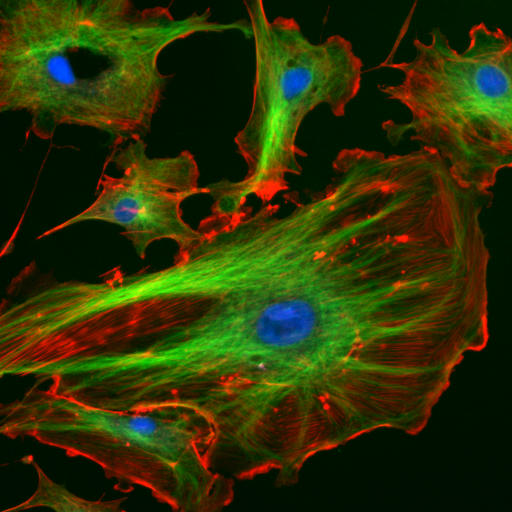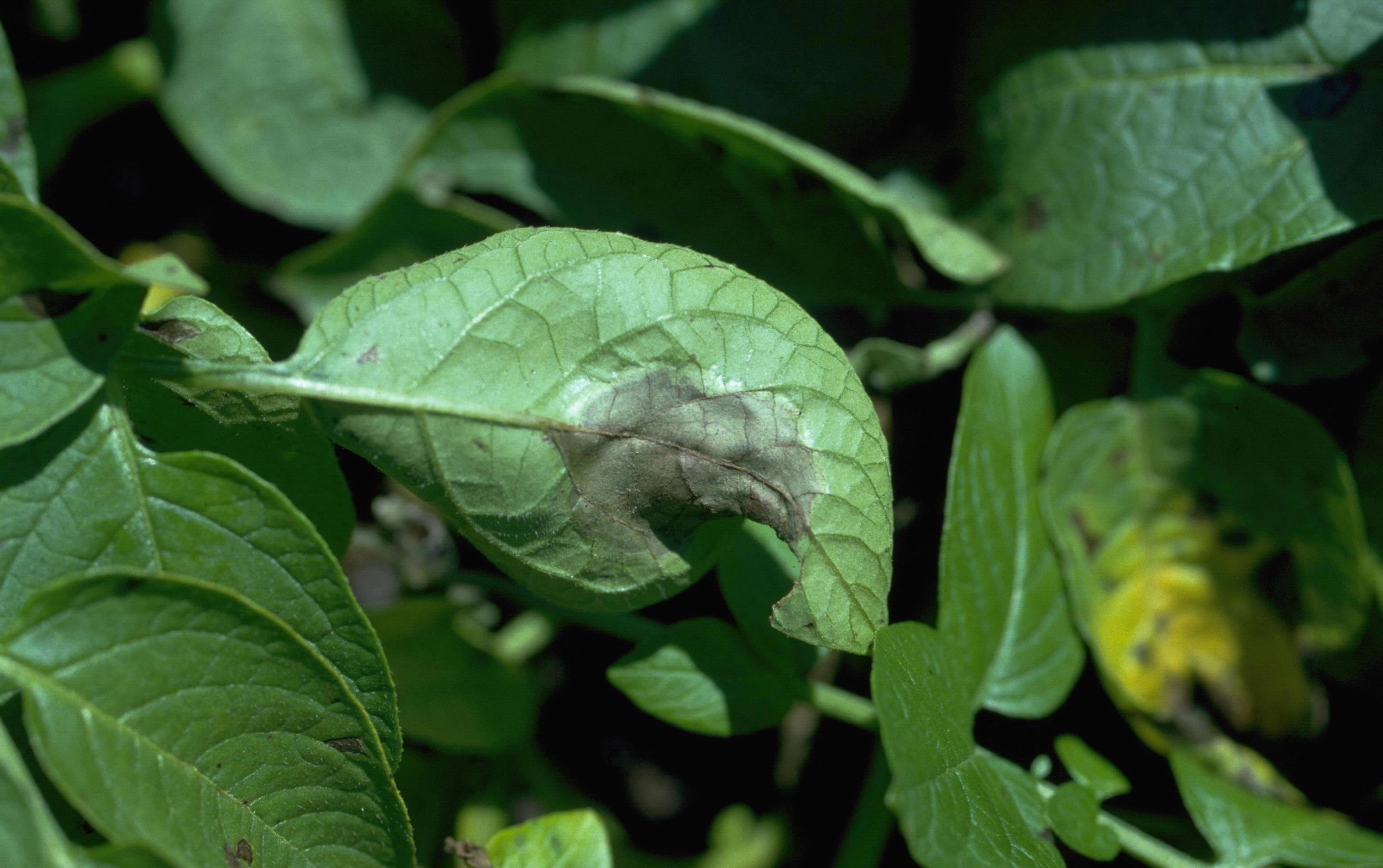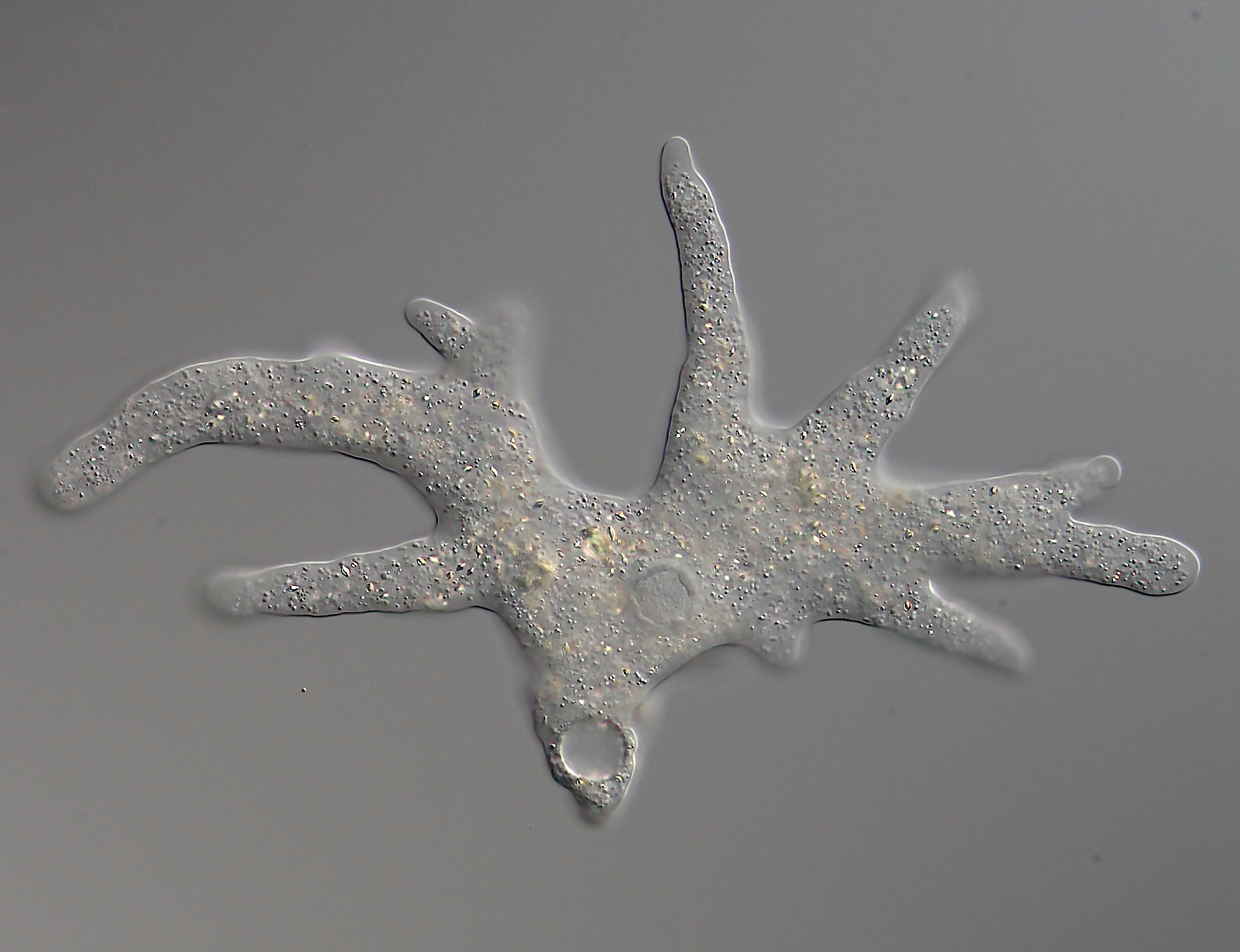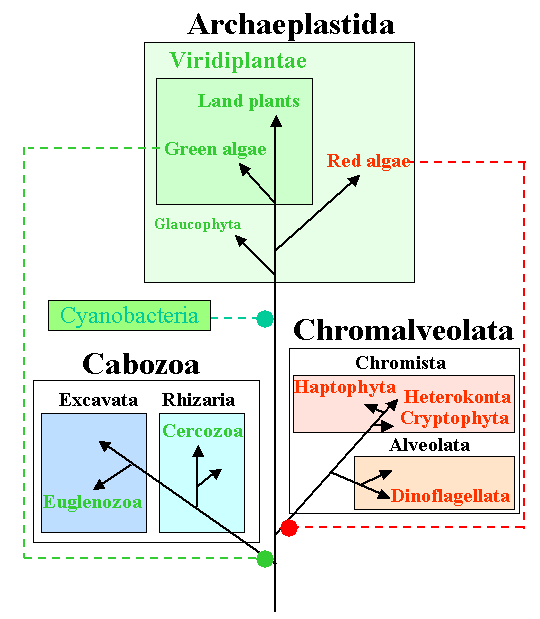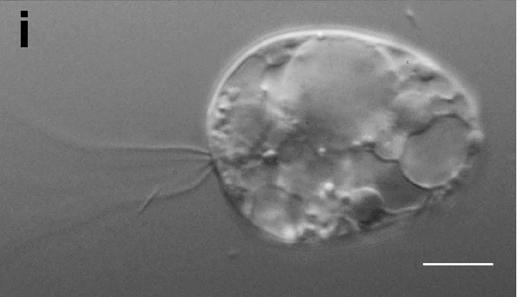|
Bikont
A bikont ("two flagella") is any of the eukaryotic organisms classified in the group Bikonta. Many single-celled and multi-celled organisms are members of the group, and these, as well as the presumed ancestor, have two flagella. Enzymes Another shared trait of bikonts is the fusion of two genes into a single unit: the genes for thymidylate synthase (TS) and dihydrofolate reductase (DHFR) encode a single protein with two functions. The genes are separately translated in unikonts. Relationships Some research suggests that a unikont (a eukaryotic cell with a single flagellum) was the ancestor of opisthokonts (Animals, Fungi, and related forms) and Amoebozoa, and a bikont was the ancestor of Archaeplastida (Plants and relatives), Excavata, Rhizaria, and Chromalveolata. Cavalier-Smith has suggested that Apusozoa, which are typically considered ''incertae sedis'', are in fact bikonts. Relationships within the bikonts are not yet clear. Cavalier-Smith has grouped the Excavata ... [...More Info...] [...Related Items...] OR: [Wikipedia] [Google] [Baidu] |
Unikont
Amorphea is a taxonomic supergroup that includes the basal Amoebozoa and Obazoa. That latter contains the Opisthokonta, which includes the fungi, animals and the choanoflagellates. The taxonomic affinities of the members of this clade were originally described and proposed by Thomas Cavalier-Smith in 2002. The International Society of Protistologists, the recognised body for taxonomy of protozoa, recommended in 2012 that the term Unikont be changed to Amorphea because the name "Unikont" is based on a hypothesized synapomorphy that the ISOP authors and other scientists later rejected. It includes amoebozoa, opisthokonts, and apusomonads. Taxonomic revisions within this group Thomas Cavalier-Smith proposed two new phyla: Sulcozoa, which consists of the subphyla Apusozoa ( Apusomonadida and Breviatea), and Varisulca, which includes the subphyla Diphyllatea, Discocelida, Mantamonadidae, Planomonadida and Rigifilida. Further work by Cavalier-Smith showed that Sulcozoa ... [...More Info...] [...Related Items...] OR: [Wikipedia] [Google] [Baidu] |
Scotokaryotes
The Scotokaryotes (Cavalier-Smith) is a proposed basal Neokaryotes, Neokaryote clade as sister of the Diaphoretickes. Basal Scotokaryote groupings are the Metamonads, the Malawimonas and the Podiata. In this phylogeny the Discoba are sometimes seen as Paraphyly, paraphyletic and basal eukaryotes. An alternative to the Unikont–Bikont division was suggested by Derelle ''et al.'' in 2015, where they proposed the acronyms Opimoda–Diphoda respectively, as substitutes to the older terms (Opimoda includes the old 'unikonts', plus some former bikonts; Diphoda includes most of the old 'bikonts', but not all). The name Opimoda is formed from the letters (shown in capitals) of opisthokont, OPIsthokonta and amoebozoa, aMOebozoa. In this phylogeny Discoba belongs to the Diphoda clade. Taxonomy A proposed cladogram is See also *Diphoda References {{Taxonbar, from=Q21399998 Eukaryote taxa Scotokaryotes, ... [...More Info...] [...Related Items...] OR: [Wikipedia] [Google] [Baidu] |
Plants+HC+SAR Megagroup
Diaphoretickes is a major group of eukaryotic organisms spanning over 400,000 species. The majority of the earth's biomass that carries out photosynthesis belongs to Diaphoretickes. In older classification systems, members of the Diaphoretickes were variously placed in the kingdoms Protozoa or Protista. Etymology The name Diaphoretickes derives (''diaforetikés'') meaning diverse, dissimilar, referring to the wide morphological and cellular diversity among members of this clade. History Eukaryotes, organisms whose cells contain a nucleus, have been traditionally grouped into four kingdoms: animals, plants, fungi and protists. In the late 20th century, molecular phylogenetic analyses revealed that protists are a paraphyletic assortment of many independent evolutionary lineages or clades, from which animals, fungi and plants evolved. However, the relationships between these clades remained difficult to assess due to technological limitations. Starting in the early 2000s, ... [...More Info...] [...Related Items...] OR: [Wikipedia] [Google] [Baidu] |
Eukaryote
The eukaryotes ( ) constitute the Domain (biology), domain of Eukaryota or Eukarya, organisms whose Cell (biology), cells have a membrane-bound cell nucleus, nucleus. All animals, plants, Fungus, fungi, seaweeds, and many unicellular organisms are eukaryotes. They constitute a major group of Outline of life forms, life forms alongside the two groups of prokaryotes: the Bacteria and the Archaea. Eukaryotes represent a small minority of the number of organisms, but given their generally much larger size, their collective global biomass is much larger than that of prokaryotes. The eukaryotes emerged within the archaeal Kingdom (biology), kingdom Asgard (Archaea), Promethearchaeati and its sole phylum Promethearchaeota. This implies that there are only Two-domain system, two domains of life, Bacteria and Archaea, with eukaryotes incorporated among the Archaea. Eukaryotes first emerged during the Paleoproterozoic, likely as Flagellated cell, flagellated cells. The leading evolutiona ... [...More Info...] [...Related Items...] OR: [Wikipedia] [Google] [Baidu] |
Diaphoretickes
Diaphoretickes is a major group of eukaryote, eukaryotic organisms spanning over 400,000 species. The majority of the earth's biomass that carries out photosynthesis belongs to Diaphoretickes. In older classification systems, members of the Diaphoretickes were variously placed in the Kingdom (biology), kingdoms Protozoa or Protist, Protista. Etymology The name Diaphoretickes derives (''diaforetikés'') meaning diverse, dissimilar, referring to the wide morphology (biology), morphological and cellular diversity among members of this clade. History Eukaryotes, organisms whose cells contain a cell nucleus, nucleus, have been traditionally grouped into four kingdom (biology), kingdoms: animals, plants, fungi and protists. In the late 20th century, molecular phylogenetic analyses revealed that protists are a paraphyletic assortment of many independent evolutionary lineages or clades, from which animals, fungi and plants evolved. However, the relationships between these clades re ... [...More Info...] [...Related Items...] OR: [Wikipedia] [Google] [Baidu] |
Eukaryote
The eukaryotes ( ) constitute the Domain (biology), domain of Eukaryota or Eukarya, organisms whose Cell (biology), cells have a membrane-bound cell nucleus, nucleus. All animals, plants, Fungus, fungi, seaweeds, and many unicellular organisms are eukaryotes. They constitute a major group of Outline of life forms, life forms alongside the two groups of prokaryotes: the Bacteria and the Archaea. Eukaryotes represent a small minority of the number of organisms, but given their generally much larger size, their collective global biomass is much larger than that of prokaryotes. The eukaryotes emerged within the archaeal Kingdom (biology), kingdom Asgard (Archaea), Promethearchaeati and its sole phylum Promethearchaeota. This implies that there are only Two-domain system, two domains of life, Bacteria and Archaea, with eukaryotes incorporated among the Archaea. Eukaryotes first emerged during the Paleoproterozoic, likely as Flagellated cell, flagellated cells. The leading evolutiona ... [...More Info...] [...Related Items...] OR: [Wikipedia] [Google] [Baidu] |
Chromalveolate
Chromalveolata was a eukaryote supergroup present in a major classification of 2005, then regarded as one of the six major groups within the eukaryotes. It was a refinement of the kingdom Chromista, first proposed by Thomas Cavalier-Smith in 1981. Chromalveolata was proposed to represent the organisms descended from a single secondary endosymbiosis involving a red alga and a bikont. The plastids in these organisms are those that contain chlorophyll c. However, the monophyly of the Chromalveolata has been rejected. Thus, two papers published in 2008 have phylogenetic trees in which the chromalveolates are split up, and recent studies continue to support this view. Groups and classification Historically, many chromalveolates were considered plants, because of their cell walls, photosynthetic ability, and in some cases their morphological resemblance to the land plants ( Embryophyta). However, when the five-kingdom system (proposed in 1969) took prevalence over the ani ... [...More Info...] [...Related Items...] OR: [Wikipedia] [Google] [Baidu] |
Opisthokonts
The opisthokonts () are a broad group of eukaryotes, including both the animal and fungus kingdoms. The opisthokonts, previously called the "Fungi/Metazoa group", are generally recognized as a clade. Opisthokonts together with Apusomonadida and Breviata comprise the larger clade Obazoa. Flagella and other characteristics A common characteristic of opisthokonts is that flagellate cells, such as the sperm of most animals and the spores of the chytrid fungi, propel themselves with a single ''posterior'' flagellum. It is this feature that gives the group its name. In contrast, flagellate cells in other eukaryote groups propel themselves with one or more ''anterior'' flagella. Flagellate cells however have been secondarily lost in some opisthokont groups, including most of the fungi. Opisthokont characteristics include synthesis of extracellular chitin in exoskeleton, cyst/spore wall, or cell wall of filamentous growth and hyphae; the extracellular digestion of substrates with ... [...More Info...] [...Related Items...] OR: [Wikipedia] [Google] [Baidu] |
Chromalveolata
Chromalveolata was a eukaryote supergroup present in a major classification of 2005, then regarded as one of the six major groups within the eukaryotes. It was a refinement of the kingdom Chromista, first proposed by Thomas Cavalier-Smith in 1981. Chromalveolata was proposed to represent the organisms descended from a single secondary endosymbiosis involving a red alga and a bikont. The plastids in these organisms are those that contain chlorophyll c. However, the monophyly of the Chromalveolata has been rejected. Thus, two papers published in 2008 have phylogenetic trees in which the chromalveolates are split up, and recent studies continue to support this view. Groups and classification Historically, many chromalveolates were considered plants, because of their cell walls, photosynthetic ability, and in some cases their morphological resemblance to the land plants ( Embryophyta). However, when the five-kingdom system (proposed in 1969) took prevalence over the animal� ... [...More Info...] [...Related Items...] OR: [Wikipedia] [Google] [Baidu] |
Cabozoa
In the classification of eukaryotes (living organisms with a cell nucleus), Cabozoa was a taxon proposed by Cavalier-Smith. It was a putative clade comprising the Rhizaria and Excavata. More recent research places the Rhizaria with the Alveolata and Stramenopiles instead of the Excavata, however, so "Cabozoa" is polyphyletic. See also * Corticata Corticata ("one with a cortex"), in the classification of eukaryotes (living organisms with a cell nucleus), is a group suggested by Thomas Cavalier-Smith to encompass the eukaryote supergroups of the following two groups: * Plantae, or Archaep ... References {{bikont-stub Obsolete eukaryote taxa Eukaryote taxa ... [...More Info...] [...Related Items...] OR: [Wikipedia] [Google] [Baidu] |
Apusozoa
The Apusozoa are a paraphyletic phylum of flagellate eukaryotes. They are usually around 5–20 μm in size, and occur in soils and aquatic habitats, where they feed on bacteria. They are grouped together based on the presence of an organic shell or theca under the dorsal surface of the cell. The name derives from the Ancient Greek words for footless () and animal (). This phylum was defined as containing the Breviata and the Apusomonadida. However, it is viewed as paraphyletic, with the Breviata as more basal. The opisthokonts appear to have emerged as sister of the Apusomonadida. It has been suggested that the Mantamonadida be classified in Apusozoa. The Ancyromonadida appear to be Varisulca, Planomonadida, shifting them possibly more basal than the Amoebozoa, or less basal. While some classification systems have placed Hemimastigida in Apusozoa, 2018 research indicated that hemimastigotes (/Hemimastix/ Spironematellidae) are their own supra-kingdom. Characteristics The ... [...More Info...] [...Related Items...] OR: [Wikipedia] [Google] [Baidu] |


